Dell 2407WFP and 3007WFP LCD Comparison
by Jarred Walton on March 2, 2007 11:30 AM EST- Posted in
- Displays
Dell 2407WFP: Appearance and Design
The 2407WFP has the typical look of a Dell LCD: a relatively narrow black bezel with silver trim. Opinions as to what looks best are going to vary, but we are generally pleased with the appearance of the Dell displays. Users interested in running multi-display configurations might want an even narrower bezel, but at roughly one inch wide it becomes difficult for manufacturers to trim much more off the width.
Like most LCDs, the 2407WFP comes with a base stand that allows you to raise, lower, tilt, and swivel the main panel. Vertical travel is a reasonable four inches, which should be enough for most people. Tilting the display will also raise the LCD several more inches.
You can rotate the display into portrait mode, although here the stand doesn't allow enough vertical travel so you have to tilt the display before rotating it. How many people are really interested in using widescreen displays in portrait mode is debatable, but at the very least it does make the process of connecting any cables much easier, since you can get a clear view of the bottom of the LCD.
All of the input ports are located on the back of the panel, facing downward. (That's why the ability to rotate the display is convenient.) As mentioned on the previous page, the 2407WFP allows up to five inputs to be used, and you can switch between inputs via the On-Screen Display (OSD).
Besides the five potential video inputs, the back of the display also comes with a USB input that allows the display to function as a USB hub. There's also a power connection for an optional speaker bar that can be attached to the bottom of the display. There are two USB ports on the rear of the panel and two more on the left side. The left side is also home to a flash memory reader that accepts most of the common formats: CompactFlash, Secure Digital, Sony Memory Stick (1, 2, and Pro), SmartMedia, and Multimedia Card; the only major format that isn't supported is xD. If you frequently find yourself using USB cables to connect your computer to a digital camera, the integrated flash memory reader is extremely convenient. Read and write performance appears to be limited by the capabilities of your flash memory.
At the bottom of the display are five buttons used to control the OSD. The far left button is a shortcut allowing you to quickly switch between video inputs, while the second button is used to toggle the Picture-in-Picture (PIP) functions. The remaining three buttons are used to access the main OSD menu and select/adjust the various options. Here's a quick look at the major functions present in the OSD.
Most of the features we like to see in an OSD are available, but if you use a digital connection some of these options are disabled. For example, screen scaling defaults to fill/stretch when using a DVI connection, and you need to use your graphics card drivers to change the scaling options. This was not the case on the older Dell 2405FPW, and frankly we preferred the ability to control this function directly from the display rather than resorting to drivers. Not all drivers have all of the necessary options, and if you run an alternative OS it is even less likely to have full control over the display scaling.
Editor's Note: The LCD we have for review is revision A01 (possibly refurbished at some point). It appears revision A04 now supports setting the scaling on DVI connections. Unfortunately, there doesn't appear to be any way to guarantee that the Dell LCD you purchase will be revision A04.
Analog connections also enable the menu items for sharpness and zoom. Contrast is locked at a set value, but you can control the brightness of the lamp and you can also adjust color options. The Image Modes menu provides three settings that can be used for various tasks, so it is possible to have three custom configurations for gaming, multimedia, and business use.
As a package, the 24" Dell LCDs have always been a popular choice among display enthusiasts, and it's easy to see why. The more recent 2407WFP improves upon the older model in several areas, chief among these being the addition of HDCP support. We also like the change in the base stand, which allows the 2407WFP to sit very close to the level of your desk. If you already have a 2405FPW, there's not necessarily a big reason to upgrade, but given the choice between the two we definitely prefer the new model. Prices have also become a lot more attractive overtime, with the 2407WFP currently selling for $675 -- compare that to the launch price of the 2405FPW, which was originally more than twice that.
The 2407WFP has the typical look of a Dell LCD: a relatively narrow black bezel with silver trim. Opinions as to what looks best are going to vary, but we are generally pleased with the appearance of the Dell displays. Users interested in running multi-display configurations might want an even narrower bezel, but at roughly one inch wide it becomes difficult for manufacturers to trim much more off the width.
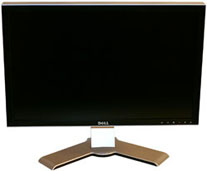 |
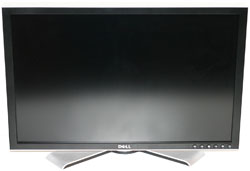 |
| Click to enlarge | |
Like most LCDs, the 2407WFP comes with a base stand that allows you to raise, lower, tilt, and swivel the main panel. Vertical travel is a reasonable four inches, which should be enough for most people. Tilting the display will also raise the LCD several more inches.
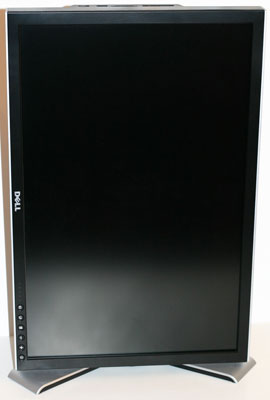 |
| Click to enlarge |
You can rotate the display into portrait mode, although here the stand doesn't allow enough vertical travel so you have to tilt the display before rotating it. How many people are really interested in using widescreen displays in portrait mode is debatable, but at the very least it does make the process of connecting any cables much easier, since you can get a clear view of the bottom of the LCD.
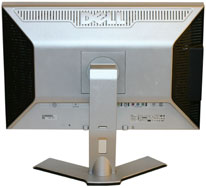 |
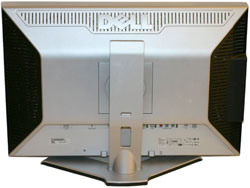 |
| Click to enlarge | |
All of the input ports are located on the back of the panel, facing downward. (That's why the ability to rotate the display is convenient.) As mentioned on the previous page, the 2407WFP allows up to five inputs to be used, and you can switch between inputs via the On-Screen Display (OSD).
 |
 |
| Click to enlarge |
Besides the five potential video inputs, the back of the display also comes with a USB input that allows the display to function as a USB hub. There's also a power connection for an optional speaker bar that can be attached to the bottom of the display. There are two USB ports on the rear of the panel and two more on the left side. The left side is also home to a flash memory reader that accepts most of the common formats: CompactFlash, Secure Digital, Sony Memory Stick (1, 2, and Pro), SmartMedia, and Multimedia Card; the only major format that isn't supported is xD. If you frequently find yourself using USB cables to connect your computer to a digital camera, the integrated flash memory reader is extremely convenient. Read and write performance appears to be limited by the capabilities of your flash memory.
At the bottom of the display are five buttons used to control the OSD. The far left button is a shortcut allowing you to quickly switch between video inputs, while the second button is used to toggle the Picture-in-Picture (PIP) functions. The remaining three buttons are used to access the main OSD menu and select/adjust the various options. Here's a quick look at the major functions present in the OSD.
 |
 |
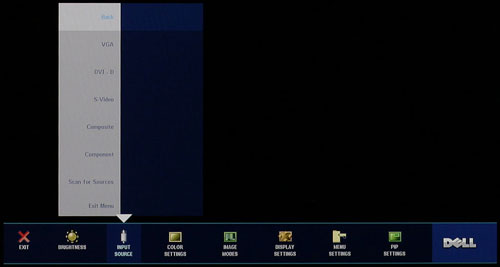 |
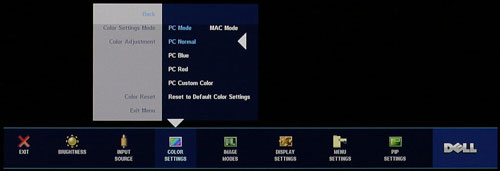 |
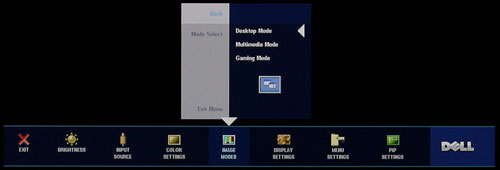 |
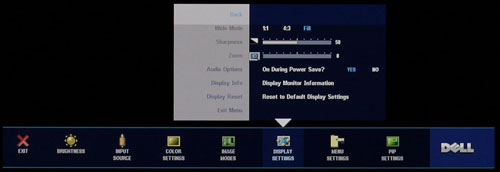 |
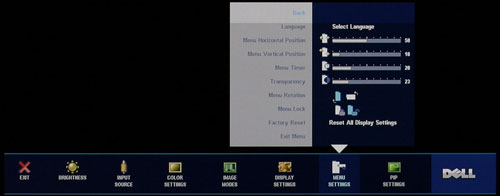 |
 |
| Click to enlarge |
Most of the features we like to see in an OSD are available, but if you use a digital connection some of these options are disabled. For example, screen scaling defaults to fill/stretch when using a DVI connection, and you need to use your graphics card drivers to change the scaling options. This was not the case on the older Dell 2405FPW, and frankly we preferred the ability to control this function directly from the display rather than resorting to drivers. Not all drivers have all of the necessary options, and if you run an alternative OS it is even less likely to have full control over the display scaling.
Editor's Note: The LCD we have for review is revision A01 (possibly refurbished at some point). It appears revision A04 now supports setting the scaling on DVI connections. Unfortunately, there doesn't appear to be any way to guarantee that the Dell LCD you purchase will be revision A04.
Analog connections also enable the menu items for sharpness and zoom. Contrast is locked at a set value, but you can control the brightness of the lamp and you can also adjust color options. The Image Modes menu provides three settings that can be used for various tasks, so it is possible to have three custom configurations for gaming, multimedia, and business use.
As a package, the 24" Dell LCDs have always been a popular choice among display enthusiasts, and it's easy to see why. The more recent 2407WFP improves upon the older model in several areas, chief among these being the addition of HDCP support. We also like the change in the base stand, which allows the 2407WFP to sit very close to the level of your desk. If you already have a 2405FPW, there's not necessarily a big reason to upgrade, but given the choice between the two we definitely prefer the new model. Prices have also become a lot more attractive overtime, with the 2407WFP currently selling for $675 -- compare that to the launch price of the 2405FPW, which was originally more than twice that.










62 Comments
View All Comments
JarredWalton - Friday, March 2, 2007 - link
Noticing motion blur is one thing; being bothered by it will vary by individual. You mentioned Titan's Quest... I played that for over 100 hours without ever being bothered by motion blur. Are the item names clearly readable while running around? Not necessarily, but I can make them out well enough, and the names are secondary to the attributes, so I always ended up checking out items in my inventory.As for that video link... if my picture of a picture was a bad representation of what it's like using a display in person - and I feel it is, even with a decent SLR and a tripod - a handheld camcorder floating around recording a display is ten times worse. Are we supposed to be judging the quality of the display output or the quality of the camcorder and its ability to record LCD screen content? Or maybe the ability of the cameraman to give a reasonable representation of the LCD content? Because it seems to me that it's focused *much* more on the latter two than on the LCD itself. You can see the camera adjusting brightness/contrast on the fly depending on how much light its getting.
Basically, I agree that motion blur can bother people. It doesn't bother me... at all. What I see when playing games just blends together into relatively smooth gameplay, and a delay of a few hundredths of a second is short enough that my old and decrepit eyes don't care. That's why I repeatedly recommend people try out a display in person, because what you get via a review online or in a magazine is a poor substitute for hands on experience. As I state on page 5:
"Most of us don't have a problem with the slight image smearing that occurs on these LCDs, and the camera actually makes it look a lot worse than what we experience in person -- we may have simply captured two frames for all we know -- but this is something that will vary by individual. If you know you are bothered by image smearing, try out a display in person to see if it's suitable for your needs."
Zebo - Friday, March 2, 2007 - link
I have no idea how you guys can't see the color shifting in those PVA's. Every PVA I have tried has had it 1905, 2405 Gateway 24 & 21 etc Color Shifing so bad, viewing straight on, one eye can actualky see something different than the other eye (because the eyes are at different angles) it gave me a headache.Viewing angles on all PVA's suck thats just a fact that other people don't notice will never change my mind compared to an IPS or CRT it's night and day difference.
Heres a good shot of what I mean
http://img108.imageshack.us/img108/9021/dell2007wf...">http://img108.imageshack.us/img108/9021/dell2007wf...
JarredWalton - Friday, March 2, 2007 - link
PVA viewing angles are worse than some of the alternatives, but really how often do you *not* view the display head on? I seriously doubt that I'm ever more than 20 degrees away from a direct frontal view, and probable within 10 degrees in most cases. If that's not how you work with your PC, then other panels might be preferable. I've just never had any real concerns with viewing angles on the 24" LCDs I've tried. Laptop LCDs on the other hand... some of those are absolutely terrible, to the point where moving your head 6" can make the display almost illegible. That too is getting better, thankfully.Zebo - Saturday, March 3, 2007 - link
I view them straight on and they eyes see something different in each due to gamma/color shift. Look, even IPS isnt 178 degrees (or 90:P) like they advertise and starts to fade get shifty at around 35-45 degrees off center but PVA is literally about 5-10 - that's enough on a widescreen to be well over 5-10 degrees at the horizontal edges. Vertical color shift is evident raising my head only about 6" from about 20" away which is the difference between sitting up the chair vs. leaning back, a common position shift for a person using thier PC all day. Horizontal color shift is everywhere from 2-3 ft away. Every PVA panel has exhibited this problem and I know I'm sensitive to it as many don't notice but OTOH many do. TN lappy? don't get me started I just spent two miserable weeks in hotel with one.JarredWalton - Saturday, March 3, 2007 - link
My future laptop reviews are going to be running these sort of color tests and such as well. Of the few laptops I've tried so far, only the ASUS G2P was "good" in my opinion. Most others are a case of "I think I can live with it...." The problem is that unlike desktop LCDs, laptop LCDs frequently aren't bright enough. They focus more on conserving battery life, and while that might be good when they're unplugged, I'd just as soon forget about battery life when plugged in if it gives a better quality display result.timmiser - Friday, March 2, 2007 - link
The idea of getting 7 more inches for $400 less by going the route of a 37" HDTV 1080p is more appealing to me. That would be big screen gaming and spreadsheet work that would be awesome! I think it would be great if AT did a comparison between those two monitors just because they have such a different approach.I would like to see how the 37" 1920x1080 resolution looks compared to the Dell 3007 native resolution. One complaint I have is that the text gets smaller when the monitor gets bigger due to the extreme resolution for the Dell. The text should stay the same or get a little bigger when going to such a big screen in my opinion.
For an extra $100, I can get a 37" 1080p HDTV with a digital tuner which would be cool to switch to an HDTV broadcast on the fly.
Deusfaux - Friday, March 2, 2007 - link
I find it weird the 3007-HC (high color) isn't mentioned, as it's been announced and some people have been able to order it over the phone. It's the 3007 but with a little bit faster response time and better color reproduction (92% of the gamut vs 70-some% on the older 3007).JarredWalton - Friday, March 2, 2007 - link
When we can get one for comparison we'll see how it fares; right now Dell still seems to be shipping more of the "old" revision, and in testing we didn't have any complaints about the quality of the colors (once calibrated). We are trying to get other LCDs to compare with the current Dell offerings, though, so stay tuned....ViRGE - Friday, March 2, 2007 - link
Is Dell actually committed to keeping the 3007 an IPS panel? After the shenanigans that was the launch of the 2007, I'm afraid they'll jump ship to PVA/MVA as soon as they can, while all the reviews still reference the IPS panel.JarredWalton - Friday, March 2, 2007 - link
There are rumors that the new HC panel revision is going to switch to a different type of panel, but for now they're still IPS as far as we're aware. Hopefully they stay that way, but if they change and quality drops, we'll do our best to cover the situation.